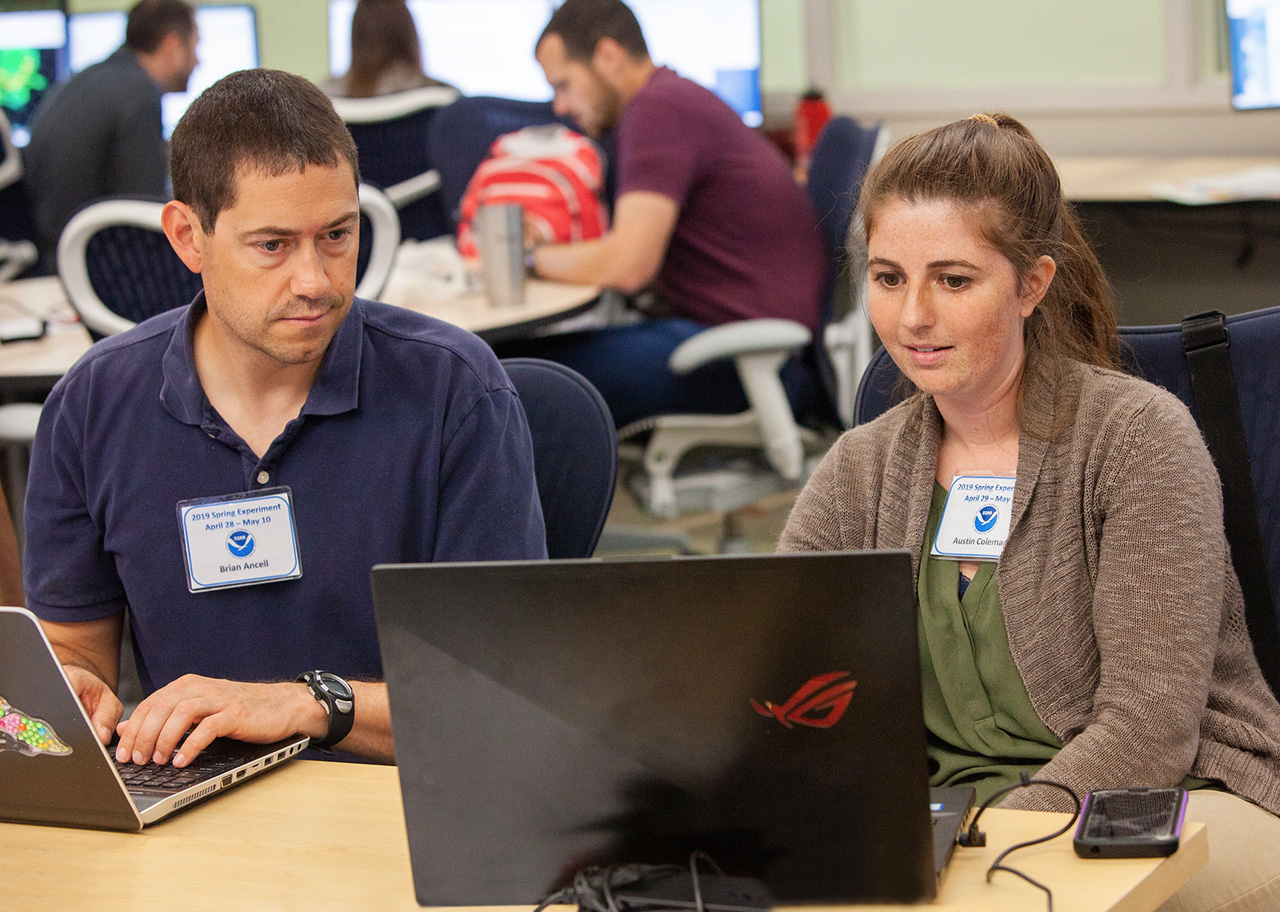Austin Coleman Wins for Best Oral Presentation

Austin Coleman (right) works with her advisor, atmospheric scientist Brian Ancell (left), at the 2019 Spring Experiment held by the National Oceanic and Atmospheric Administration (NOAA).
Atmospheric Science Ph.D. Student Awarded at Weather Conference
4.14.2022 | Toni Salama
Austin Coleman, a Ph.D. student of atmospheric science in the Department of Geosciences, received the Best Oral Presentation Award at the 5th Texas Weather Conference held April 1-2 at Texas Tech's International Cultural Center.
Coleman, who presented her ongoing thesis work, concentrates her research on developing a computational tool that will provide an understanding of how atmospheric features influence the predictability of high-impact weather events such as severe thunderstorms later in the day.
Coleman said she always had an interest in the natural world. Then, when she was a young high-schooler, a specific precipitating event led her to meteorology.
“It happened when a weak tornado developed very close to my front yard in early high school. I had always been afraid of storms, but as my dad and I watched it pass from the front porch, that fear was immediately replaced by curiosity,” Coleman said. “From there I learned that math and physics were involved, and I've been hooked ever since.”
Using ensemble sensitivity analysis (ESA), Coleman is developing tools that can adjust forecasts to be more accurate in the prediction of severe hazards like tornadoes, hail and high winds. Her goal is to integrate these tools in the National Weather Service forecasting process so that they become an industry standard.
Understanding the Potential of ESA
According to Coleman's research abstract:
“ESA is a useful and computationally inexpensive tool for analyzing how features in the flow at early forecast times affect different relevant forecast features later in the forecast window.”
The ESA data may then be used to increase predictability and forecast accuracy through an objective ensemble subsetting technique, which can consistently and significantly improve high-impact weather forecasts.
“However, realizing this strong intrinsic potential in real-world scenarios remains a challenge due to a myriad of factors,” according to Coleman's abstract. “One obstacle to the technique's optimization is the fundamental gap between model diagnostics (e.g., updraft helicity, simulated reflectivity, etc.) and our observational datasets for severe weather (e.g., storm reports).
“To overcome this fundamental gap, a machine learning algorithm is trained on a deterministic model dataset to explicitly predict local storm reports, which is subsequently applied to the TTU ensemble system to create storm report response functions for use with subsetting.
“Once optimized, the subsetting algorithm will be ready to move beyond the Hazardous Weather Testbed into the wild, where it will need to be tested regionally and in real-time to further assess its potential in an operational setting.
“It is our hope to bring the subsetting algorithm to a handful of National Weather Service Weather Forecast Offices in the Southern Region for testing during summer 2022 to gain forecaster feedback on the tool.”
Looking Ahead
Coleman is a member of Texas Tech's Atmospheric Science Group, working under the advisement of atmospheric scientist Brian Ancell. But as she moves toward graduation, she looks forward to the next step in her career.
After attaining her Ph.D., Coleman hopes to work for a research institution with a team of scientists developing tools that improve severe weather prediction, likely by means of high-resolution weather models.
“If I can help forecasters—and subsequently the public—in some way with these techniques, I'll be a happy camper,” Coleman said.
College of Arts & Sciences
-
Address
Texas Tech University, Box 41034, Lubbock, TX 79409-1034 -
Phone
806.742.3831 -
Email
arts-and-sciences@ttu.edu
